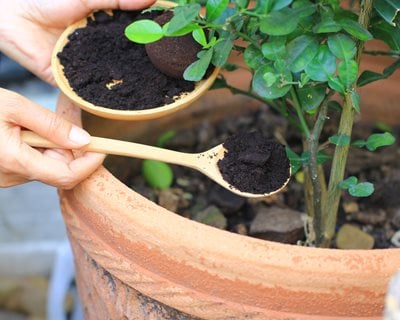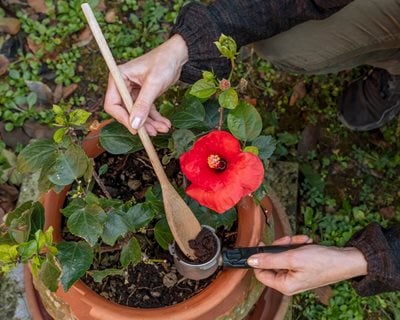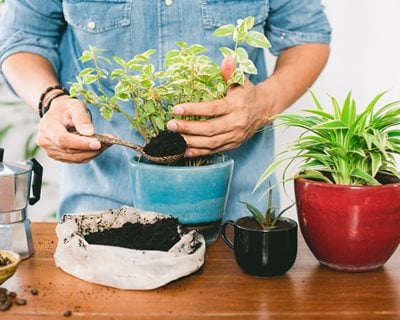Coffee Grounds for Plants: A How-To Guide
How to use coffee grounds to help your plants thrive
Photo by: Monthira / Shutterstock.
Most gardeners know that coffee grounds can be beneficial to plants. But what do they actually do and how do you use them in your garden? The use of coffee grounds is somewhat controversial, with some extolling the virtues and others warning of possible adverse effects. It all comes down to what works for you and your garden.
When used properly, there are many benefits to using coffee grounds in the garden. Here’s how to get the most out of using coffee grounds for your soil, garden, and indoor houseplants.
ARE COFFEE GROUNDS GOOD FOR PLANTS?
Coffee grounds can improve overall plant health and vigor. However, when not used correctly and in the right amounts, grounds may actually be harmful to your soil and plants. Some types of plants will benefit more than others. Before using coffee grounds or adding organic material to your garden, get your soil tested for pH levels and to see what nutrients your soil needs.
WHAT DO COFFEE GROUNDS DO FOR PLANTS?
Coffee grounds help to enhance the soil and provide nutrients to plants. As they break down, coffee grounds release nitrogen, an essential nutrient for healthy foliage growth. They are also a source of other primary nutrients including potassium and phosphorus, as well as micronutrients such as boron, calcium, copper, iron, magnesium, and zinc.
Find out more on soil basics.
PROS OF USING COFFEE GROUNDS
Reduces waste. Using coffee grounds in your garden is a way to recycle. Coffee shops are a good source of larger amounts and are happy to give away used grounds for free to keep them out of the landfill.
Feeds earthworms. There are mixed opinions on whether coffee grounds are beneficial or harmful to earthworms. Worms love coffee grounds and will eat them as a food source. Beneficial earthworms produce their own nutrient-rich waste, aerate the soil, and help to break down compost to make soil nutrients available to plants.
Tip: Grounds can be added to worm bin composting systems. Make sure to include other food sources such as vegetable scraps, shredded paper, cardboard and wood shavings, limiting the amount of coffee grounds to no more than 25-50% of the total materials. Adding too much grounds can cause bins to become too acidic or overheat as the nitrogen in coffee grounds breaks down, killing the worms.
Improves soil structure and drainage. Soil that is compacted, too wet, or poorly draining can lead to root rot or disease problems. The coarse texture of coffee grounds helps aerate soil, allowing water and nutrients to reach plant roots more efficiently. Make sure to mix grounds well into the soil.
Water retention. Amending soil with coffee grounds improves water retention, enhancing the health of moisture-loving plants such as bleeding heart, canna lily, cardinal flower, hosta, primrose, and spiderwort. Avoid using grounds in waterwise landscapes or around low water plants.
Aids in composting. Coffee grounds help to sustain ideal temperatures needed break down organic matter in a compost pile by releasing nitrogen, which produces heat and accelerates decomposition. The nitrogen in coffee grounds also encourages the growth of beneficial microorganisms in the soil.
Acts as a slow-release fertilizer. When added directly to soil, coffee grounds slowly release nutrients into the soil, feeding plants over a period of time.
Helps control disease. Research suggests that decomposing coffee grounds produce beneficial bacterial and fungal species that may prevent harmful diseases and fungi from establishing.
CONS OF USING COFFEE GROUNDS
Toxicity to dogs. In large quantities, coffee grounds may be harmful to dogs if ingested. If you have a dog that likes to taste new things, you may want to avoid using coffee grounds in your garden.
May inhibit plant growth. Caffeine is a natural compound found in coffee plants that reduces competition from other nearby plants. Coffee grounds can inhibit seed germination and cause stunting of plants. Avoid using coffee grounds around young seedlings or new plants. Using too much coffee grounds around mature plants can also cause stunting and suppressed root growth.
May be harmful to beneficial bacteria. Soil contains many different types of bacteria, some beneficial and some harmful. And while the use of coffee grounds may prevent some harmful bacteria and fungi from establishing, some good bacteria may also be killed off, leaving plants more susceptible to pests and diseases.
Creates a barrier. When coffee grounds are placed by themselves in a layer on top of the soil, it can form a solid barrier when the grounds dry out, preventing water and fertilizer from penetrating into the soil. It is best to use just a light sprinkling on top of the soil, no more than 1/8 inch.
HOW TO USE COFFEE GROUNDS

Photo by: Marco Taliani de Marchio / Shutterstock.
When adding coffee grounds, make sure they comprise no more than 20% of the total materials. Adding a higher percentage of grounds can result in stunted plant growth or other problems. Make sure grounds are broken up, especially the tightly packed fine grounds generated from espresso machines.
Compost: Mix brown compost material such as shredded leaves, wood chips, or pine needles with green compost material such as kitchen scraps, fresh plant trimmings, eggshells, and coffee grounds for a nutrient-rich source of organic matter. Use a 3:1 ratio of brown materials to green. Natural or unbleached paper coffee filters can be composted along with coffee grounds. Read more on composting.
Mulch: Combine fresh or composted coffee grounds with shredded dry leaves, grass clippings, or straw and spread around the base of plants to suppress weeds, retain moisture, and keep roots cool in summer. Mix coffee grounds well into other materials to avoid developing a top crust, which can impede water and fertilizer from reaching the root zone.
Add to soil: Composted coffee grounds can be added directly to soil or potting mix to fertilize plants. Make sure to mix them in well.
Use as a liquid fertilizer: A dilution of coffee grounds in water can be applied as a liquid fertilizer. Add 2 cups of coffee grounds to 5 gallons of water and allow to steep overnight. Use to water containers and garden beds, or as a foliar spray.
HOW TO PREPARE COFFEE GROUNDS FOR PLANTS
Though gardeners most often use grounds that have been brewed, fresh coffee grounds can also be used. Only composted coffee grounds should be mixed into the soil, as fresh grounds will have a higher acid and caffeine content which may burn plant roots. Make sure that grounds aren’t too wet to discourage possible mold. Grounds that dry out can become compacted, impeding the delivery of water and fertilizer into the soil.

Photo by: Nor Gal / Shutterstock.
WHAT PLANTS CAN I PUT COFFEE GROUNDS ON?
Coffee grounds are neutral to slightly acidic (pH can range from about 6.2 to 6.8), with fresh grounds containing more acid, which can affect soil pH. Acidic-loving plants such as azaleas, blueberries, hydrangeas, rhododendrons, and roses will benefit from a sprinkling of coffee grounds around the base of plants.
Vegetable crops that may benefit from coffee grounds include carrots, cucumbers, peppers, potatoes, and radishes. Whether or not tomato plants benefit from the use of coffee grounds is inconclusive.
WHAT PLANTS DO NOT LIKE COFFEE GROUNDS?
Since coffee grounds retain moisture, avoid using on plants that prefer drier soil such as cacti and succulents. Avoid using grounds on plants that prefer alkaline soil such as asparagus, beets, geranium, lavender, rosemary, and spiderwort.
COFFEE GROUNDS FOR INDOOR PLANTS
Houseplants can also benefit from the use of coffee grounds, though some may benefit more than others. Houseplants that prefer acid soil will be more receptive to coffee ground use. These include African violet, croton, gloxinia, monstera, peperomia, and philodendron. Avoid using coffee grounds on aloe vera, orchids, and pothos.
Sprinkle a very small amount of grounds directly in the pot or mix well into potting soil before planting. You can also use a liquid fertilizer made from water and coffee grounds to water your plants.
Source: Using Coffee Grounds in Gardens and Landscapes, Washington State University Extension, Dr. Linda Chalker-Scott
RELATED:
Garden Soil 101
Garden Fertilizer 101
